Overview
The article "9 Early Symptoms of Autism Every Parent Should Recognize" is a heartfelt guide aimed at helping parents identify crucial early signs of autism. By recognizing symptoms such as:
- Communication delays
- Social interaction challenges
- Unusual play behaviors
Parents can take proactive steps toward timely intervention. Research supports the idea that early detection and intervention can significantly enhance developmental outcomes for children on the autism spectrum. This knowledge empowers parents to act with confidence and compassion, ensuring their children receive the support they need to thrive.
Introduction
In a world where awareness and understanding of autism spectrum disorder (ASD) are vital for creating nurturing environments, parents hold a crucial position in recognizing early signs and navigating the complexities of their child's development. Communication delays, social interaction challenges, sensory sensitivities, and emotional responses can all present themselves in various ways.
This article explores the multifaceted aspects of autism, offering insights into identifying symptoms, emphasizing the importance of early intervention, and presenting strategies that empower parents to support their children effectively. By shining a light on these essential areas, we aim to equip families with the knowledge and resources necessary to enhance their child's quality of life and foster positive outcomes.
About ASD Media: Empowering Parents with Autism Resources
At ASD Media, we are deeply committed to advancing the implementation of Applied Behavior Analysis (ABA) therapy. Our mission is to offer valuable insights and strategies that address common challenges while improving outcomes for families and professionals alike. We strive to create a supportive and inclusive community where individuals can share their experiences, learn from one another, and receive guidance on their journeys.
By subscribing to our newsletter, families gain access to the latest news and unlimited digital resources designed to empower them. We focus on unlocking the potential of children with neurodevelopmental disorders and ADHD through effective strategies that manage challenging behaviors, navigate support services, and enhance social skills development.
Recent trends highlight the importance of a client-centered approach in ABA therapy, emphasizing the perspectives and preferences of individuals and their families. Through case studies, we illustrate how ABA interventions can greatly improve adaptive behaviors and self-sufficiency in young individuals, leading to a better quality of life and overall happiness. As children master essential life skills, they experience greater autonomy, showcasing the profound impact of ABA therapy on their developmental outcomes.
As we at ASD Media often say, "The impact of positive reinforcement on behavior change is profound." This underscores the critical role of positive reinforcement in effective ABA practices. Furthermore, our organization is dedicated to promoting collaboration and development within the ABA therapy community, ensuring that caregivers have the support they need to help their children flourish. We also address the latest trends in resource accessibility for individuals on the spectrum, making it easier for parents to find the support they require.
Communication Delays: Recognizing Early Signs of Autism
Communication delays are often among the early symptoms of autism, and it's crucial for parents to be vigilant. Look out for early symptoms of autism, including:
- A lack of babbling by 12 months
- The absence of single words by 16 months
- If a young child does not respond to their name
- Struggles with back-and-forth conversations
These may be considered early symptoms of autism that indicate significant communication delays. Studies reveal that approximately 20% of children with developmental disorders do not babble by their first birthday, which underscores the importance of recognizing early symptoms of autism for timely intervention.
The Childhood Autism Rating Scale (CARS) stands out as the most commonly used assessment tool, utilized by 38.0% of individuals aged 4 years. This underscores the value of evaluation instruments in the early detection of the early symptoms of autism and other developmental disorders. Early intervention is vital, particularly in addressing the early symptoms of autism, as it can lead to meaningful improvements in language development and overall communication skills. Programs like the CDC's 'Learn the Signs' focus on educating about the early symptoms of autism.
It is important to act early when identifying the early symptoms of autism. The initiative emphasizes the importance of developmental monitoring, equipping caregivers and professionals with the resources needed to recognize the early symptoms of autism and other delays promptly. Successful outcomes from early intervention programs illustrate that timely support can significantly enhance communication abilities in children with autism, fostering better social interactions and developmental progress.
However, parents should also be aware of the average cost of therapeutic behavioral services, which is $175.44, as financial considerations can impact access to essential interventions. As Zachary Warren, a training consultant for OCALI, points out, understanding the early symptoms of autism and the resources available is crucial for parents navigating this challenging journey. Moreover, there is an urgent need for equitable identification and service eligibility, ensuring that all families can access timely support for their children.
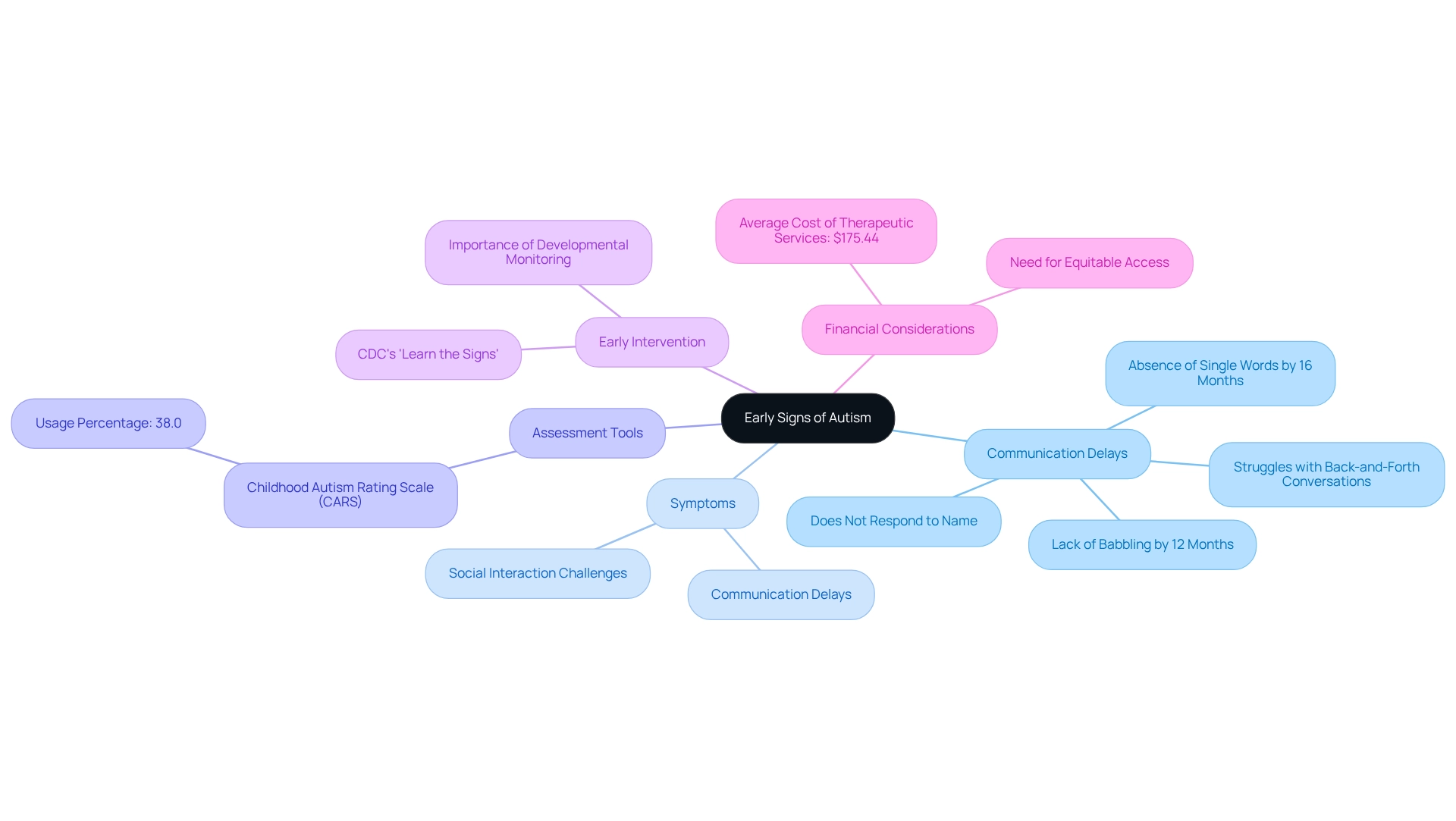
Social Interaction Challenges: Identifying Autism Symptoms
Children with developmental disorders often encounter significant challenges in their interpersonal interactions. Many parents may notice the early symptoms of autism, including:
- Limited eye contact
- Difficulty interpreting social cues
- A reduced interest in engaging with peers
Research shows that around 40% of children with autism struggle with eye contact, which can impede their ability to connect with others. Additionally, many children find it hard to share enjoyment or interests, further isolating them from communal experiences, which makes recognizing the early symptoms of autism crucial. It empowers parents to seek targeted therapies aimed at enhancing interpersonal skills. The DSM-5 outlines criteria for diagnosing autism, including deficits in communication and interaction, alongside restricted, repetitive behaviors. Recent studies reveal the effectiveness of interventions designed to bolster social skills, demonstrating that early intervention can lead to meaningful improvements in social engagement.
Significantly, statistics indicate that 75% of youth can transition to regular school after early intervention, underscoring the importance of addressing these challenges promptly. Furthermore, a case study suggests that the rise in reported cases of autism is partly due to improved diagnostic tools, which allow for more accurate identification of the early symptoms of autism. By understanding these early symptoms of autism and seeking appropriate support, parents can play a vital role in nurturing their children’s social development. If you find yourself facing similar challenges, consider reaching out for help and resources that can guide your family toward a brighter social future.

Repetitive Behaviors: A Key Indicator of Autism
Repetitive actions, such as hand-flapping, rocking, or spinning objects, are often considered early symptoms of autism spectrum disorder (ASD). These behaviors can serve as coping strategies for anxiety or sensory overload, providing comfort in challenging moments. It's important to note that research indicates these behaviors are more prevalent in toddlers than in preschoolers among typically developing individuals. This highlights the significance of early observation for parents to identify the early symptoms of autism. By closely monitoring their children's behavior patterns, parents can consider structured interventions that effectively manage these actions. Such interventions have been shown to decrease the frequency and intensity of repetitive behaviors, ultimately enhancing the overall well-being of young individuals.
A recent analysis by the ADDM Network utilized statistical methods to examine ASD prevalence. It revealed that individuals with ASD and intellectual disabilities tend to receive diagnoses at a younger age compared to those without. Specifically, the analysis indicates that the median age at diagnosis is significantly lower for youths with both ASD and intellectual disabilities. This underscores the critical need for early identification and intervention regarding the early symptoms of autism. Additionally, data suggests that individuals born in 2016 are 1.6 times more likely to receive a diagnosis of ASD by age four compared to those born in 2012. This trend towards earlier diagnosis is something guardians should recognize and embrace.
Experts emphasize the importance of repetitive actions as indicators of the condition, with behavioral therapists advocating for customized approaches to manage these behaviors. For instance, Yui conducted a 12-week intervention involving DHA and arachidonic acid (ARA) on individuals with ASD, resulting in significant improvements in repetitive behaviors. This finding highlights the potential of specific dietary interventions in managing these behaviors. Effective interventions not only help in addressing these actions but also support the development of coping mechanisms for anxiety, which often intertwines with repetitive actions. By nurturing a supportive atmosphere and employing evidence-based approaches, parents can greatly enhance their children's ability to navigate the difficulties associated with neurodevelopmental challenges.
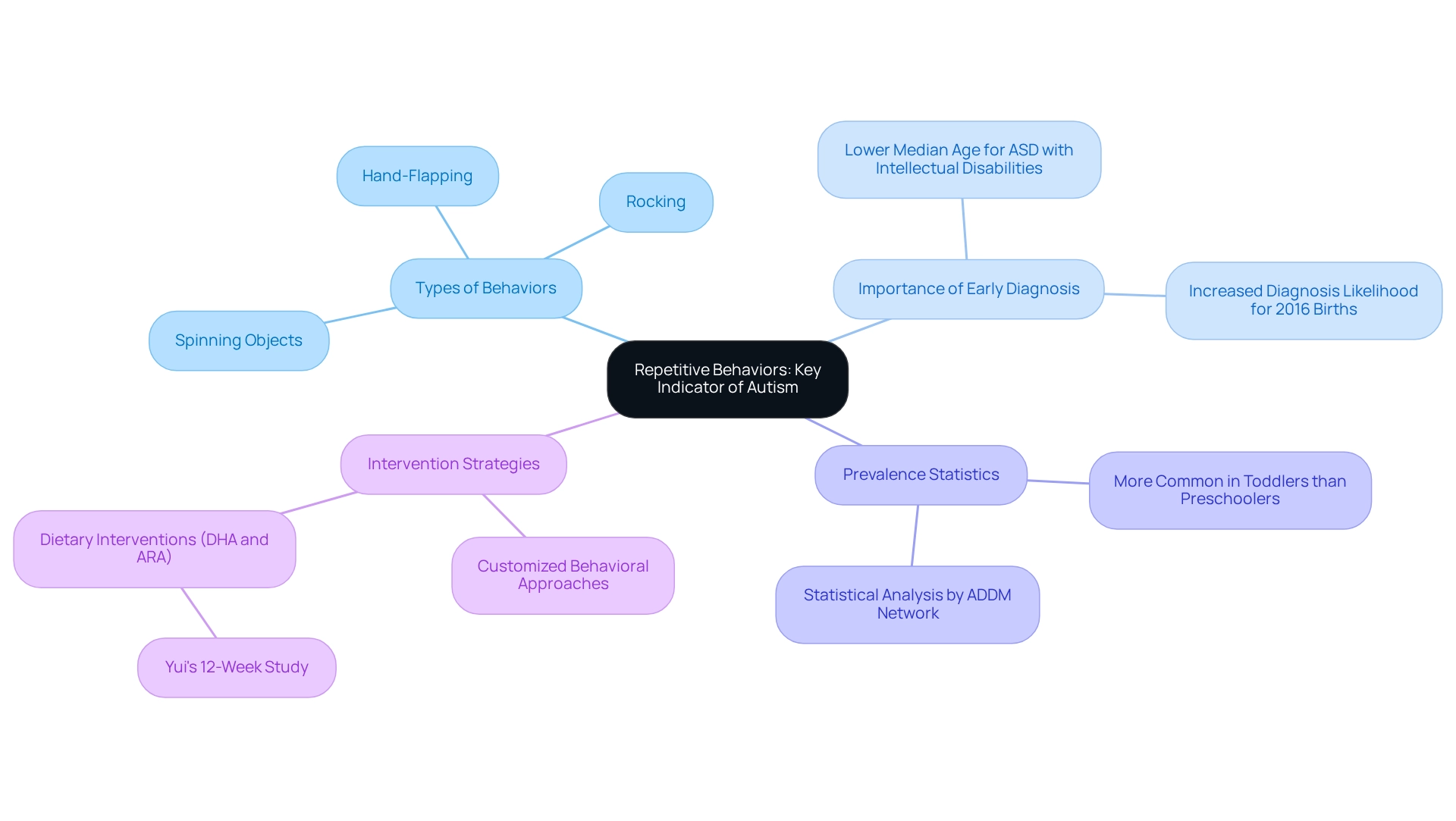
Sensory Sensitivities: Understanding Autism Symptoms
Children with autism often experience sensory sensitivities, which can manifest as either hypersensitivity or hyposensitivity to various stimuli. Hypersensitivity may lead a young person to feel overwhelmed by loud noises or bright lights. Conversely, those with hyposensitivity might actively seek out intense sensory experiences, such as rolling on surfaces instead of sitting or standing. This behavior can sometimes be misinterpreted; individuals who are hyposensitive may be perceived as bullies due to their intense interactions with peers. Understanding these sensory profiles is crucial for guardians and caregivers, as it enables them to implement strategies that promote safe and suitable physical interactions, ultimately minimizing misunderstandings in social situations.
Creating a sensory-friendly environment is essential for reducing distress and fostering positive experiences. Occupational therapists emphasize the importance of customizing environments to meet sensory needs. They recommend that parents collaborate with IEP teams—individualized education programs designed to address the specific needs of youth with disabilities—or explore a 504 plan, which provides accommodations to ensure equal access to education. Statistics indicate that sensory sensitivities are prevalent among youth with autism, with many encountering significant challenges related to their sensory processing.
For instance, the density of mechanoreceptors in human fingertips exceeds 1,000 per cm, highlighting how acute sensitivity to tactile input can shape young people's experiences. A relevant case study titled 'Hyposensitivity to Tactile Input' illustrates how youngsters may be misjudged as bullies due to their intense and sometimes painful touch. Understanding these sensitivities can lead to effective interventions, enhancing the overall well-being of youth with developmental disorders. As Jerónimo Javier González-Bernal notes, the sensory environment plays a critical role in the experiences of young individuals with developmental disorders. By fostering an inclusive and supportive atmosphere, parents can help their children navigate sensory challenges, ultimately unlocking their potential and improving their quality of life.
Developmental Milestone Delays: Signs of Autism
As parents, it's essential to closely observe your child's developmental milestones, such as walking, talking, and social interactions. Delays in these areas can be concerning and may indicate the early symptoms of autism. While research shows variability in developmental progress, some children may not walk until after 15 months, which can be a red flag. Additionally, if your little one isn't showing social smiles by 9 months, this could also warrant attention.
Regular pediatric check-ups are vital for tracking these milestones. They provide valuable opportunities for early evaluations and interventions when necessary. Effective early intervention initiatives have shown that prompt assistance can significantly improve outcomes for children with developmental delays. Experts stress the importance of monitoring these milestones, as they can serve as critical indicators of the early symptoms of autism. For instance, children who crawled on their hands and knees typically walked an average of 0.9 months earlier than those who shuffled on their bottoms.
Dr. Karen Gill highlights, "Many parents and caregivers are eager for the walking milestone, while others worry about the safety risks it presents." This statement reflects the mixed emotions many feel during this developmental stage. The CDC recognizes the need for accessible resources, offering Spanish-language materials to help families understand and support their children's development effectively. This initiative ensures that Spanish-speaking families can access essential information about youth development, fostering better support for their children.
By promoting awareness and understanding of these milestones, you can better advocate for your child and seek the necessary support. Remember, you are not alone in this journey—many parents share similar concerns, and together we can navigate these important developmental stages.
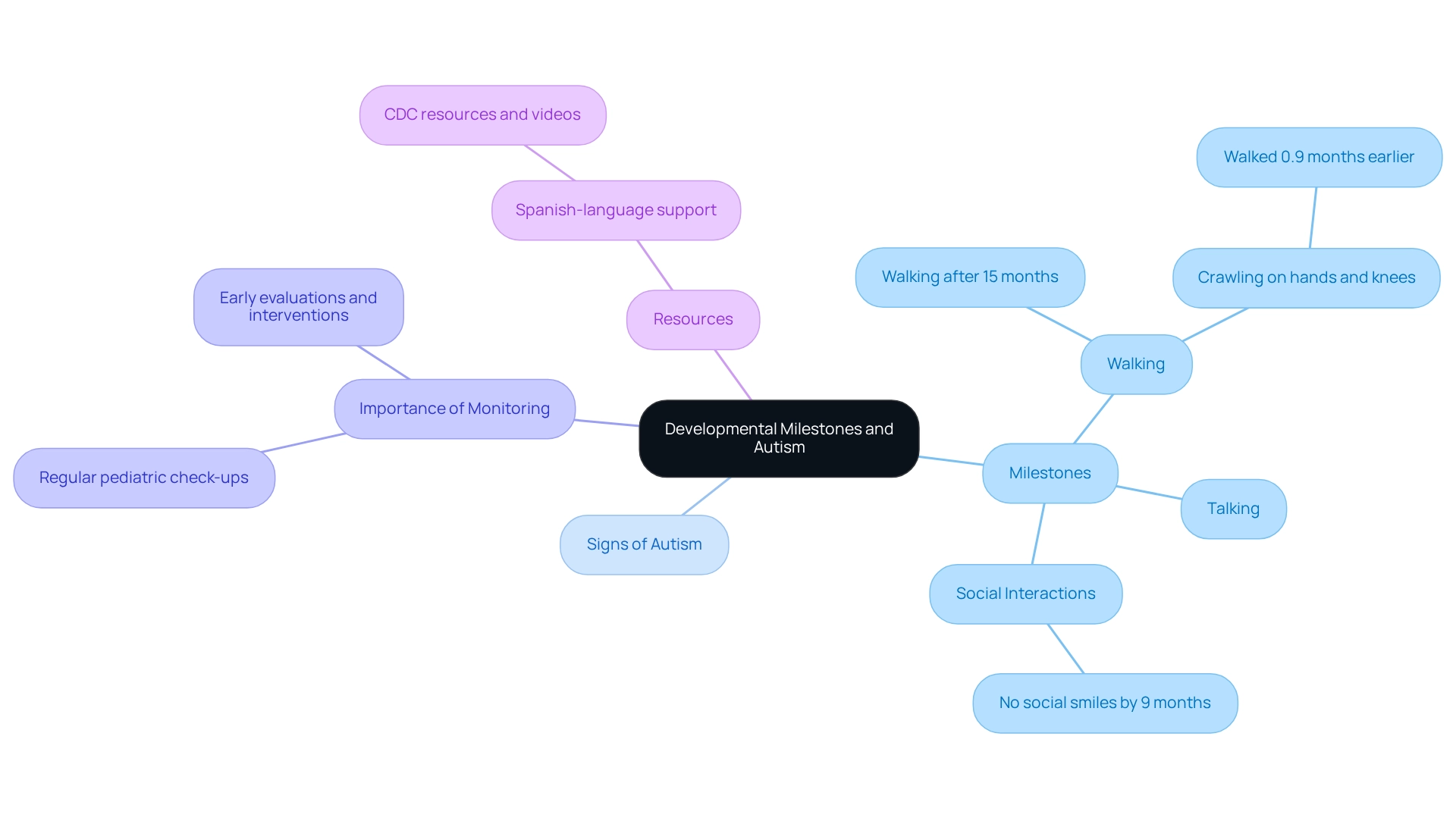
Unusual Interests: Recognizing Autism Symptoms
Children with autism often display profound interests in specific subjects, such as dinosaurs, trains, or certain TV shows. These passions can exceed typical childhood fascinations, frequently dominating their playtime and social interactions. While these interests can serve as valuable pathways for joy and learning, it is crucial for guardians to encourage a balance with other activities to foster well-rounded development.
To cultivate this balanced approach, parents can adopt effective strategies that weave these unique interests into play. For instance, leveraging a child's enthusiasm for trains to teach mathematical concepts or social skills can create engaging learning experiences. Case studies reveal that classrooms employing ABA support to integrate students' interests witness enhanced engagement and fewer behavioral challenges, underscoring the potential advantages of this method. Specifically, the case study titled "Transforming Classroom Dynamics with ABA Support" illustrates how incorporating students' interests can elevate classroom dynamics and boost overall student participation.
Expert insights emphasize that balancing intense interests with communal play is vital for developing interpersonal skills. Encouraging young individuals to share their passions with peers can facilitate social interactions and strengthen communication abilities. As Dr. Stephen Shore wisely notes, 'If you’ve met one person with a developmental disorder, you’ve met one person with a developmental disorder,' which underscores the uniqueness of each child's journey and the necessity of tailored strategies to support their growth. Furthermore, with 828 subscribers, ASD Media fosters a nurturing community where caregivers can access resources and share experiences related to navigating the challenges of autism.
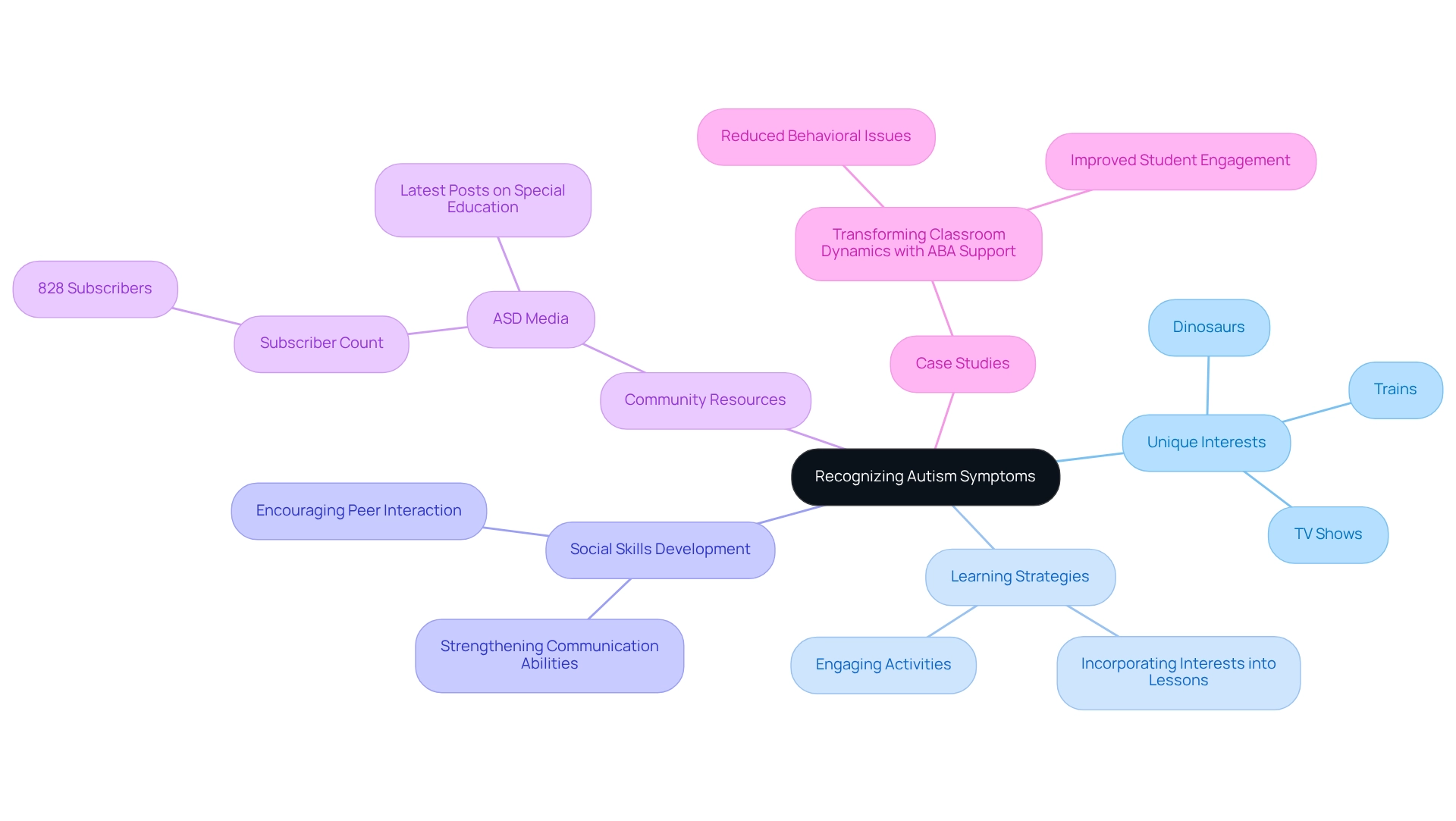
Emotional Responses: Identifying Signs of Autism
Children on the spectrum often display intense emotional responses, such as meltdowns or disproportionate reactions to minor stimuli. These emotional patterns can arise from atypical sensory processing, complicating their ability to express feelings or understand the emotions of others. Understanding these reactions is crucial for guardians, as many children exhibit early symptoms of autism and can learn to manage their emotions more effectively through appropriate interventions and support.
To help manage intense emotional reactions, parents can implement several strategies:
- Establish a Routine: Consistent daily schedules can provide a sense of security and predictability, reducing anxiety and emotional outbursts.
- Teach Emotional Vocabulary: Helping children articulate their feelings can empower them to express themselves more effectively, potentially decreasing frustration.
- Use Visual Supports: Visual aids, such as emotion charts, can assist young individuals in recognizing and labeling their emotions, fostering better emotional awareness.
- Practice Relaxation Techniques: Methods like deep breathing or mindfulness can help children calm down during overwhelming situations.
Statistics indicate that the early symptoms of autism, such as emotional dysregulation, are common among children, with many experiencing frequent meltdowns. A study revealed a Cohen’s Kappa Coefficient of 0.86 for inter-observer agreement on emotional responses, underscoring the reliability of these observations among professionals. This prevalence highlights the urgency of implementing effective strategies for emotional regulation.
Case studies, such as those detailing successful ABA therapy programs in Georgia, illustrate how tailored interventions can empower families to navigate emotional challenges effectively. These programs often focus on individualized approaches that enhance emotional regulation, leading to better outcomes for children. By integrating these strategies, families can address the emotional responses that may lead to meltdowns.
Expert opinions emphasize the importance of recognizing the early symptoms of autism for effective early intervention. As psychologist Keefer notes, "So it could be kind of a vicious cycle in that way," emphasizing how addressing emotional responses early can prevent escalating behaviors. By nurturing a supportive environment and employing effective methods, parents can significantly enhance their children's emotional well-being and overall development.

Differences in Play Behavior: Early Signs of Autism
Children with developmental disorders often exhibit unique play behaviors that set them apart from their peers. Many may find themselves drawn to solitary play or engage in repetitive activities, such as lining up toys, rather than participating in imaginative play. Research indicates that children on the autism spectrum may show variations in their gestures, imaginative play, and communication skills, which can hinder their ability to connect with others.
As Jillian M. Pierucci, PhD, notes, 'Grasping these distinctions is essential for guardians and caregivers to aid in their offspring's development effectively.' A study titled 'Exploring Play Competencies in Children with Autism' found minimal similarities in play behaviors across various assessment measures, underscoring the complexity of evaluating play skills.
Additionally, certain play abilities were significantly linked to expressive and receptive language skills, fine motor skills, and visual reception skills, highlighting the necessity for diverse approaches in assessing children's developmental progress. Recognizing early symptoms of autism is crucial for caregivers to foster interactive play and address these differences early on.
Effective strategies for promoting peer interaction include:
- Modeling appropriate play behaviors
- Creating opportunities for structured playdates
Experts emphasize that understanding the factors that inhibit interactive play—such as communication challenges, limited interests, and peer exclusion—can empower caregivers to implement effective interventions. By observing and addressing solitary and repetitive play patterns, such as encouraging turn-taking during play or introducing new games, caregivers can better support their children in developing vital social skills and enriching their overall play experiences.
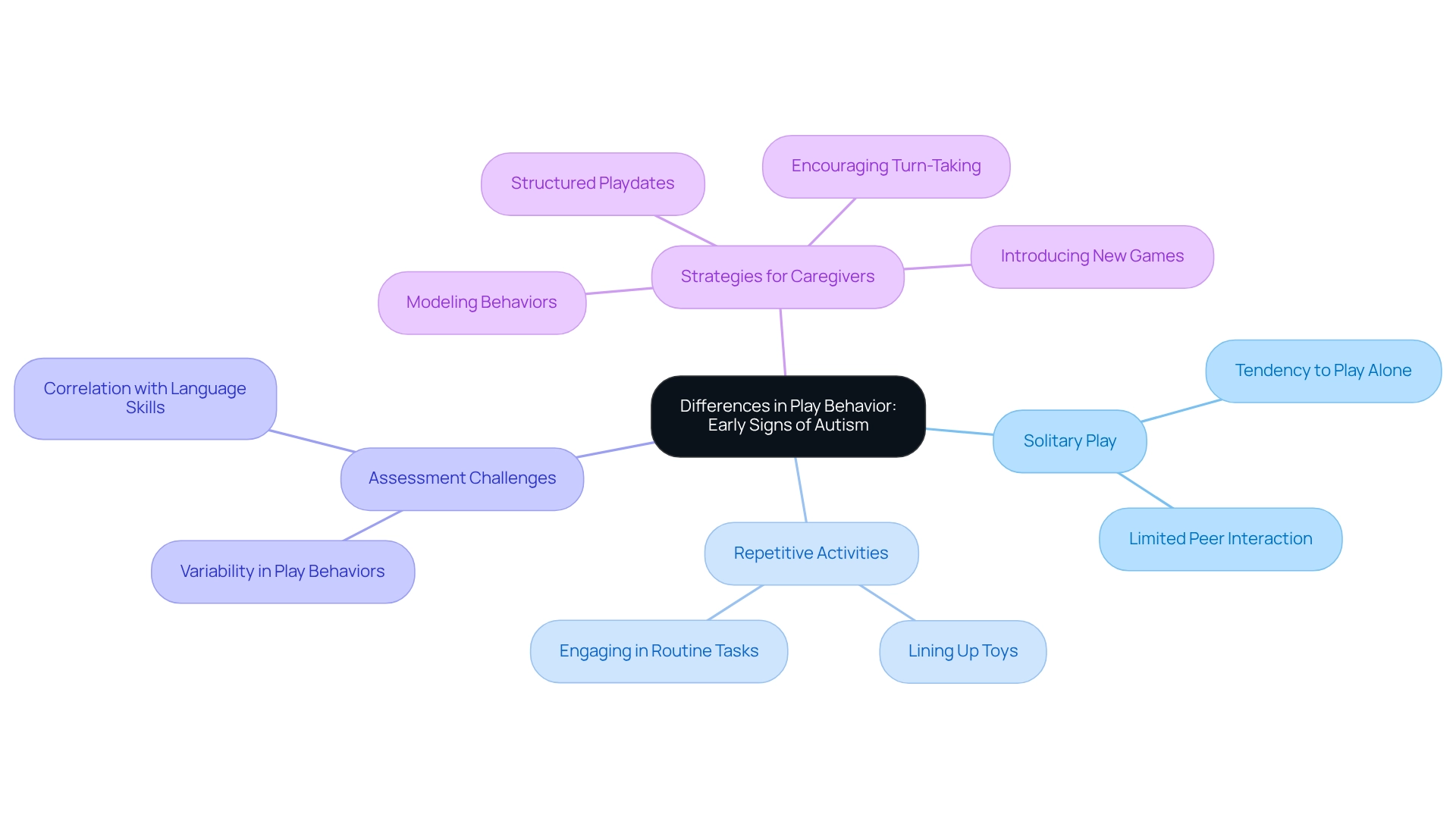
Seeking Professional Evaluation: Next Steps for Parents
When guardians notice early symptoms of autism in their children, seeking a professional assessment becomes essential. This evaluation can begin with a pediatrician or a specialist in developmental disorders. Timely identification of the early symptoms of autism is vital, as it opens the door to effective measures that can significantly enhance a young person's developmental journey. Research shows that delays in treatment can negatively impact a child's growth and opportunities, highlighting the need for prompt action.
To prepare for the evaluation, parents should carefully document their observations and concerns. This preparation not only aids professionals in understanding the child's behavior and needs but also fosters a collaborative approach to care. Experts emphasize that a strengths-based perspective during assessments can positively influence how the condition is perceived. As Marilyn J. Montiero, PhD, notes, sharing a strengths-focused narrative about the individual can help reinterpret diagnostic criteria as strengths rather than limitations, boosting confidence in both the child and their caregivers. In 2025, the importance of recognizing early symptoms of autism for early diagnosis continues to be paramount. The DSM-5 now includes coding notes for related medical or genetic conditions, alongside other neurodevelopmental, mental, or behavioral disorders, reflecting the evolving understanding of evaluations for autism. Parents should recognize that statistics indicate individuals showing significant deficits in social communication, yet not meeting the criteria for autism spectrum disorder, should be assessed for social (pragmatic) communication disorder. This underscores the necessity of thorough evaluations to ensure that all young individuals receive the support they need.
As a practical tip, guardians are encouraged to keep a detailed log of their child's behaviors, noting specific examples that illustrate their concerns. This documentation will not only assist professionals during the evaluation but also empower parents to advocate effectively for their child's needs.
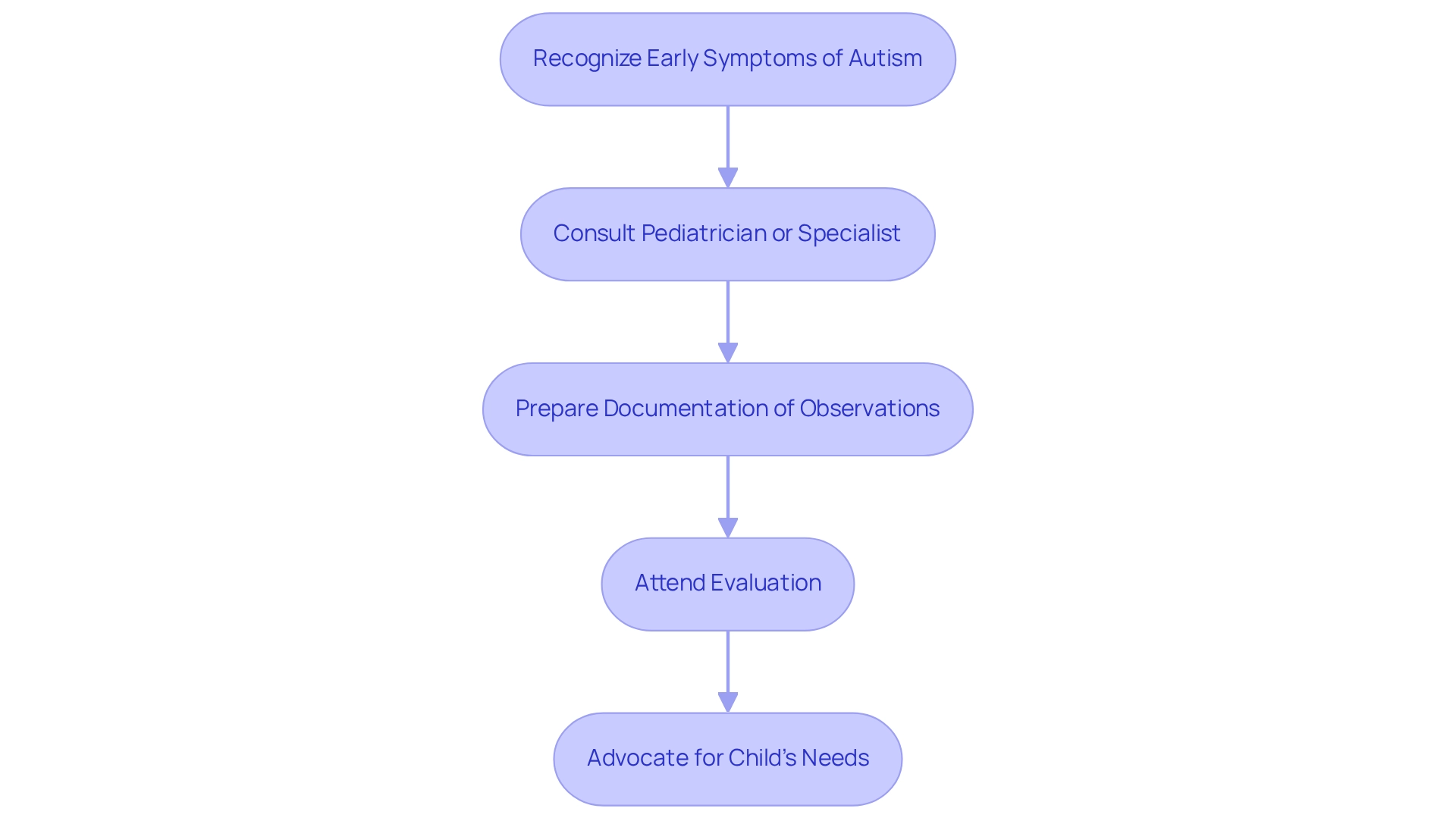
Conclusion
Recognizing and understanding the signs of autism spectrum disorder (ASD) is essential for parents who wish to support their children's development effectively. Early detection is crucial, with communication delays, social interaction challenges, sensory sensitivities, and emotional responses serving as key indicators of autism. By remaining vigilant and informed, parents can identify these signs and seek appropriate interventions that enhance their child's quality of life.
The significance of early intervention cannot be overstated. Timely support through programs such as Applied Behavior Analysis (ABA) therapy has been shown to significantly improve outcomes for children with autism. Parents are encouraged to leverage available resources, including those provided by organizations like ASD Media, to navigate the complexities of autism and access tailored strategies that promote their child's growth.
Ultimately, creating a supportive and inclusive environment is vital for children with autism. By understanding their unique needs and implementing effective strategies, parents can help their children navigate challenges, develop essential skills, and unlock their full potential. Awareness and action are key components in the journey toward supporting children with autism, enabling families to create nurturing spaces that foster positive developmental outcomes.
Frequently Asked Questions
What is the mission of ASD Media?
ASD Media is committed to advancing the implementation of Applied Behavior Analysis (ABA) therapy by providing valuable insights and strategies to improve outcomes for families and professionals while fostering a supportive and inclusive community.
How can families benefit from subscribing to the ASD Media newsletter?
By subscribing to the newsletter, families gain access to the latest news and unlimited digital resources designed to empower them, focusing on strategies to manage challenging behaviors and enhance social skills development for children with neurodevelopmental disorders and ADHD.
What is the significance of a client-centered approach in ABA therapy?
A client-centered approach emphasizes the perspectives and preferences of individuals and their families, which is important for tailoring ABA interventions to improve adaptive behaviors and self-sufficiency, ultimately enhancing the quality of life for young individuals.
What role does positive reinforcement play in ABA therapy?
Positive reinforcement is critical in effective ABA practices, as it significantly impacts behavior change and helps children master essential life skills, leading to greater autonomy and improved developmental outcomes.
What are some early symptoms of autism that parents should look out for?
Parents should be vigilant for early symptoms of autism, including a lack of babbling by 12 months, absence of single words by 16 months, failure to respond to their name, and struggles with back-and-forth conversations.
What is the Childhood Autism Rating Scale (CARS)?
The Childhood Autism Rating Scale (CARS) is the most commonly used assessment tool for autism, utilized by 38.0% of individuals aged 4 years, and helps in the early detection of autism and other developmental disorders.
Why is early intervention important for children with autism?
Early intervention is vital as it can lead to meaningful improvements in language development and overall communication skills, fostering better social interactions and developmental progress.
What is the average cost of therapeutic behavioral services?
The average cost of therapeutic behavioral services is $175.44, which can impact access to essential interventions for families.
How can early identification of autism symptoms benefit children?
Early identification empowers parents to seek targeted therapies that enhance interpersonal skills, leading to improved social engagement and the potential for 75% of youth to transition to regular school after early intervention.
What resources are available for parents to help identify early symptoms of autism?
Initiatives like the CDC's 'Learn the Signs' program focus on educating caregivers about early symptoms of autism and provide resources for developmental monitoring to ensure timely support for children.




